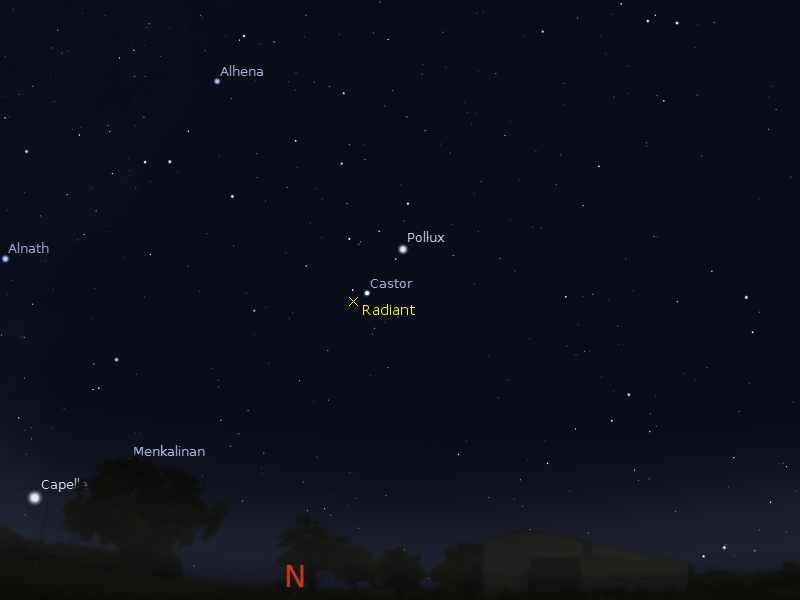

| Visitors Now: | |
| Total Visits: | |
| Total Stories: |

| Story Views | |
| Now: | |
| Last Hour: | |
| Last 24 Hours: | |
| Total: | |
Geminid Meteor shower, 14-15 December 2012
The radiant of the Geminid meteor shower above the northern horizon as seen from Adelaide on the morning of December 14 at 3:00 pm ACDST, similar views will be seen from other sites at equivalent local times. The radiant is marked with a cross (click to embiggen).
The Geminid Meteor shower will be at its peak from the point of view of Australian’s on the mornings of Friday 14 December (the actual peak is 13 December 23h30m UT ) and Saturday 15 December but significant numbers should be also be seen on the morning of the 13th.
The Moon will be out of the picture, being just off New (New Moon is on the 13th) so this is an excellent year to observe. In Australia we should see roughly a meteor every 2 minutes between 2-3 am daylight saving time under dark sky conditions. The more light pollution (the closer you are to the city) , the fewer meteors you see, but it is still worth while to look even if you are near the city or in the suburbs.
To observer the radiant, look to the north or north-east (depending on the time, the later you look the closer to north you should look). The radiant, where the meteors appear to come from, is just below Castor, the lower of the two bright, close stars that form the “twins” of Gemini.
When looking, be sure to let your eyes adjust for at least 5 minutes so your eyes can be properly adapted to the dark. Don’t look directly at the radiant site, because the meteors will often start their “burn” some distance from it, but around a handspan up or to the side. Be patient, although you should see an average of a meteor every two minutes, a whole stretch of time can go by without a meteor, then a whole bunch turn up one after the other.
Make yourself comfortable, choose an observing site that has little to obstruct the northern horizon, have a comfortable chair to sit in (a banana lounger is best), or blankets and pillows. A hot Thermos of something to drink and plenty of mosquito protection will complete your observing preparations.
As well as meteors, keep an eye out for satellites (see Heavens Above for predictions from your site). The sky will also be particularly beautiful, with the constellations of Orion and Taurus gracing the north-western sky, Jupiter setting in the west and Saturn and Venus rising in the east.
You can check meteor rate predictions for you local site with the NASA meteor flux estimator (scroll down to 4 Geminids in the SHOWER box, make sure you have your location and date correct as well). You can follow world wide Geminid counts at the IMO live Geminid site.
Cloud cover predictions can be found at SkippySky.
2012-12-07 17:02:53
Source: http://astroblogger.blogspot.com/2012/12/geminid-meteor-shower-14-15-december.html
Source:



